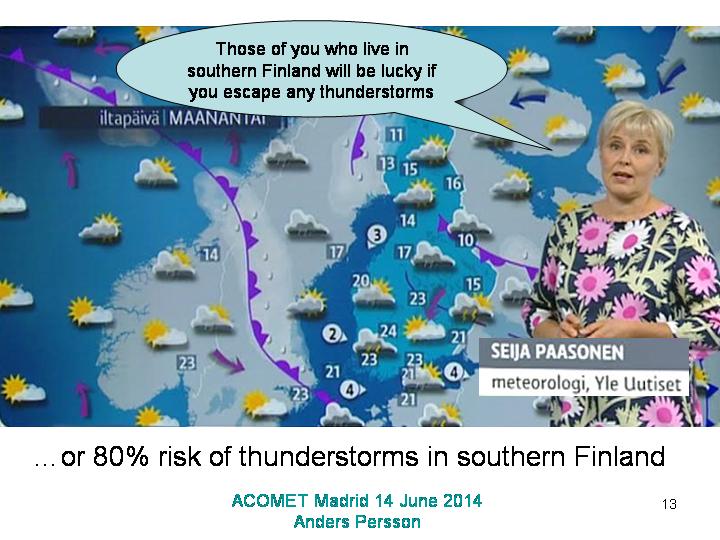Meeting “meteorological communicators”
Contributed by Anders Persson, a HEPEX guest columnist for 2014
Last winter I worked on a biography of Vilho Väisälä, the Finnish meteorologist who started Finland’s first high-tech company producing meteorological instruments. For different reasons, I needed a translation of the Finnish title “Maailman tunnetuin meteorologi?” (The world’s most famous meteorologist?) into Spanish. So I contacted Manuel Palomares at the Spanish Met Service. When we got to know each other, 20 years ago, he was Chief Forecaster, now he was promoted to International Secretary.
When we had sorted out the Spanish translation (“El meteorólogo más conocido en el mundo?), we continued to discuss common meteorological interests. Manuel told me that a debate about probability forecasting had just started in the Spanish meteorological community, more specifically in their Society’s quarterly journal “Tiempo y Clima”. A piece by Robert Mureau (formerly KNMI and ECMWF, now Meteogroup) in an ECMWF Newsletter (see pages 22-24 here) had inspired the former Head of the forecast office Angel Rivera, to make some comments (“Qué futuro tiene la predicción probabilista?”; in English, “What is the future for probabilistic forecast?” here).
Angel Rivera is a very experienced meteorologist and forecaster. After he retired as Head of the Central Forecast Office in Madrid he became president of ACOMET, La Asociación de Comunicadores de Meteorología, the Association for Meteorological Communicators. Manuel told me that Rivera was organizing a conference in June on the communication of probability forecasts and wondered if I would like to participate and contribute.
Of course, it was difficult to say no! I was even more inspired when it turned out that my contribution would be to write an extensive article in “Tiempo y Clima” as a “warm up” to my presentations, which would be in two parts, 45 minutes each.
My article (in Spanish here, in English here) was supposed to join in the debate on why probabilities are not popular with the public. My angle was that probabilities are not popular with meteorologists either, mainly because a traditional lack of statistical culture in the meteorological education. At the end I sketched a week’s course to remedy the situation (also displayed at the ECMWF User Meeting the week before, see here).
Of the two presentations at the ACOMET conference, the first (here) developed the weekly course in more detail. The second (here) presented a “spectrum” of ways to convey uncertainty information, from deterministic but “filtered” forecasts (leave out less important uncertain details) over different types of non-numerical ways to the full fledged probability approach, where still “tricks” as “framing” and use of “ base rates” can enhance and clarify the numbers.
Presenting forecast uncertainties in a professional way can be done in many ways without necessarily presenting them as percentages. This slide from my ACOMET talk is one of the examples from point 3 in the 7-point scale of how to present uncertainties in non-numerical ways that still would imply qualitatively rather specific probabilities.
The author between Benito Elvira and Jose Antonio Garcia-Moya, both specialists in probabilistic prediction at the Spanish Met Service (AEMET), at the Second Round Table ACOMET Seminar 14 June. (Photo Acomet)
To be honest, before coming to Madrid I was a bit sceptical about addressing “meteorological communicators”. From some other countries I had got the impression that such “communicators” might be young and beautiful, but not much interested in theory. The Spanish meteorological communicators were indeed young and beautiful, but also very interested in theory. They came up with some very penetrating questions after my talk, as penetrating as those I got from Spanish meteorologists some days later when I repeated the talk at their Met Service (see here).
Most of the communicators had their background as university educated physicists, geophysicists and environmental scientists. They knew about “weather” but at the same time could have an unrestricted view on the meteorological science from “outside”. Have a look at Angel Rivera’s blog “No podemos escaparnos de las probabilidades” (if your Spanish lets you down, try the Google translation – it is not too bad).
Leaving Madrid on Monday afternoon with +30°, I arrived the next day in Tromsö, northernmost Norway, with +7° to attend the 29th bi-annual Nordic Meteorological Meeting and deliver a summary of the Madrid talks.


0 comments